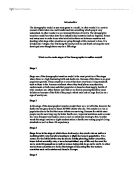Why does the demographic transition concept continue to occupy a central position in the analysis of change in human populations?
Why does the demographic transition concept continue to occupy a central position in the analysis of change in human populations?
Population can be defined as the total number of people living in that particular country at any one time. Population figures change from year to year due to increases and decreases of people within that country. These fluxes can be determined by a change in birth and death rates and also encompasses immigration and migration in or out of a country. If a particular country has more births than deaths the population will increase this is also known as natural increase. However, if I country experiences more deaths than births the population will decrease also known as natural decrease. Many countries worldwide have experienced dramatic changes in population this change in population is known as the demographic transition.
A demographic transition model can be used to view the changing population of a country over a period of time. The demographic transition model describes a sequence of changes over a period of time in relationships between birth rates and death rates and overall population change. On a demographic transition model it displays both birth rates and death rates. The birth rate of a country is the number of live births per 1,000 population per year, and the death rate is the number of deaths per 1,000 population per year. There are 4 main stages to the demographic transition model:
1. High stationary
2. Early expanding








